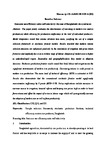Resource use efficiency under self-selectivity: the case of Bangladeshi rice producers
| dc.contributor.author | Rahman, Sanzidur | |
| dc.date.accessioned | 2015-12-25T10:50:16Z | |
| dc.date.available | 2015-12-25T10:50:16Z | |
| dc.date.issued | 2011-04 | |
| dc.identifier.issn | 1364-985X | |
| dc.identifier.issn | 1467-8489 | |
| dc.identifier.uri | http://hdl.handle.net/10026.1/4014 | |
| dc.description.abstract |
The paper jointly evaluates the determinants of switching to modern rice and its productivity while allowing for production inefficiency at the level of individual producers. Model diagnostics reveal that serious selection bias exists, justifying the use of a sample selection framework in stochastic frontier models. Results revealed that modern variety selection decisions are influenced positively by the availability of irrigation and gross return from rice and negatively by a rise in the relative wage of labour. Adoption of modern rice is higher in underdeveloped regions. Seasonality and geography/location does matter in adoption decisions. Stochastic production frontier results reveal that land, labour and irrigation are the significant determinants of modern rice productivity. Decreasing returns to scale prevail in modern rice production. The mean level of technical efficiency (MTE) is estimated at 0.82. Results also demonstrate that the conventional stochastic frontier model significantly overestimates inefficiency by three points (MTE=0.79). Policy implications include measures to increase access to irrigation, tenurial reform and keeping rice prices high to boost farm returns and offset the impact of a rise in the labour wage which will synergistically increase the adoption of modern rice as well as farm productivity. © 2011 The Authors. AJARE © 2011 Australian Agricultural and Resource Economics Society Inc. and Blackwell Publishing Asia Pty Ltd. | |
| dc.format.extent | 273-290 | |
| dc.language | en | |
| dc.language.iso | en | |
| dc.publisher | Wiley | |
| dc.subject | Bangladesh | |
| dc.subject | modern rice producers | |
| dc.subject | sample selection framework | |
| dc.subject | stochastic production frontiers | |
| dc.subject | technical efficiency | |
| dc.title | Resource use efficiency under self-selectivity: the case of Bangladeshi rice producers | |
| dc.type | journal-article | |
| dc.type | Journal Article | |
| plymouth.author-url | https://www.webofscience.com/api/gateway?GWVersion=2&SrcApp=PARTNER_APP&SrcAuth=LinksAMR&KeyUT=WOS:000289297400008&DestLinkType=FullRecord&DestApp=ALL_WOS&UsrCustomerID=11bb513d99f797142bcfeffcc58ea008 | |
| plymouth.issue | 2 | |
| plymouth.volume | 55 | |
| plymouth.publication-status | Published | |
| plymouth.journal | Australian Journal of Agricultural and Resource Economics | |
| dc.identifier.doi | 10.1111/j.1467-8489.2011.00537.x | |
| plymouth.organisational-group | /Plymouth | |
| plymouth.organisational-group | /Plymouth/Faculty of Arts, Humanities and Business | |
| plymouth.organisational-group | /Plymouth/Users by role | |
| dc.identifier.eissn | 1467-8489 | |
| dc.rights.embargoperiod | Not known | |
| rioxxterms.versionofrecord | 10.1111/j.1467-8489.2011.00537.x | |
| rioxxterms.licenseref.uri | http://www.rioxx.net/licenses/all-rights-reserved | |
| rioxxterms.type | Journal Article/Review |


